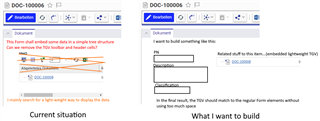Hi community,
I am playing around with displaying some data structure as Tree-Grid-View in Forms. The amount of data is very small.
Normally we can display Tree-Grid-View data in relationships or pop-up dialogs. But I don´t want that users have to click around every time they need to see the data. It´s data that´s useful for daily work, so it would be super useful when it´s directly accessible within the Form.
I discovered that it is possible to display Tree-Grid-Views in Forms. But from my POV the regular TGV layout is a little bit too heavy for my use case. I only want to display a small amount of data (only one data column, not much levels). Basically I just need the TGV data, no toolbar, no headers, no actions. Just a simple view to the data.
Does anyone now a more lightweight rendering variants for TGVs?
Thanks for any input!
Angela


